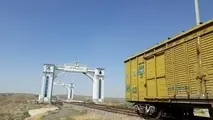U30C Locomotive history in Iran
The turbocharger failures in Iran were finished and the experience was set as a positive challenge between the customer and manufacturer that finally improved the product Quality and performance not only for Iran but also in Middle Eastern railways as well as GE Co. market position.

The first batch of 64 U30C locomotives for the Iranian railway, RAI, was delivered in 1992. The locomotive was intentionally considered very similar to GT26CW locomotives which were very successful from their first introduction in 1971 in RAI. Their traction power was 3000 HP the axle load was 20 tons and the Gauge was 1435 mm. Even their traction performance (Tractive Effort) was initially considered similar to GT26 which could pull 1000-ton trains in 1 %grade but during the complementary negotiation and according to RAI's achievement to increase it by 50% to 1500 tons, it was accepted by GE that the U30C can pull 2000 tons in 1% grade.
There were also some requirements in control and protection systems as well that were accepted and after final agreements, the production started. Inspection before the delivery was done by Iranian railway experts in Erie, USA, and it revealed some shortcomings in design and manufacturing and this was the main reason to suggest the toughest scenario during the initial two-year guarantee phase. This suggestion was accepted in RAI HQ and the full train loads were considered for these locomotives This was the beginning of repeated failures in the engine, traction motors, ….
Here we will review the diesel engine section failures that were mainly in turbochargers and were reported to the manufacturer experts and claimed to the GE representative in Iran. By growing the number of failures the company assigned a technical delegation and the meetings started.
With the proof of the shortcomings of GE, the production of U30C was stopped and negotiations continued to fix the defects of them. With the experience of statistical investigation and analysis of GT26 turbocharger failures in RAI that started in 1990 and the result of statistical analysis of U30C turbocharger failures in 1992 we in RAI predicted the possibility of turbocharger overspeed because of high altitude and high temperature at the same time so we requested the turbocharger (TC) speed curves based on inlet temperature and elevation to see if the worst operational condition (was even rare in Middle East) has been considered or not. The original radiator chart showed that with a power output of 3250hp at 1420 m, the water temp. leaving the engine to reach 103°C at an ambient temp. of 40°C with the engine derating point set at 113°C, while the locomotive operation with 2 or 3 units in consist could increase the inlet temperature for the second and third loco causing TC overspeed.
The GE experts tried to find and raise other reasons but according to the RAI team's technical reasons, finally, they accepted the insufficient cooling capacity of the locomotives, and the cooling system was enlarged in the second group of locomotives (C30-7), and for the first group (U30C) the modification drawings, instructions and new radiators … were sent to be done locally by WP Co. in Iran.
The water temperature out of the engine for the new cooling system at 40°C and 1420 m elevation was 86C was reduced by 18°C compared to the original design and at 45°C it was 92°C could not be sustained in the original design. The modifications were done locally and effectively in the first type (U30C) and the second type (C30-7) was redesigned and manufactured with a new radiator type in the Erie factory.
Conclusion: The turbocharger failures were finished and the experience was set as a positive challenge between the customer and manufacturer that finally improved the product Quality and performance not only for Iran but also in Middle Eastern railways as well as GE Co. market position.
It should be mentioned that the C30-7 locomotive could pull more than 2800 tons in 1% grade and after 30 years, is one of the best locomotives in the RAI fleet, this result created a new approach in new orders with maximum similarity to US domestic locomotives that could be seen in Saudi Arabian and Emirate railways approach for freight locomotives similar to US domestic locomotives that made a big gain both in performance, Quality and operating costs for these railways and also the operational practices similar to heavy haul railways that caused productivity improvements and its economical results.




